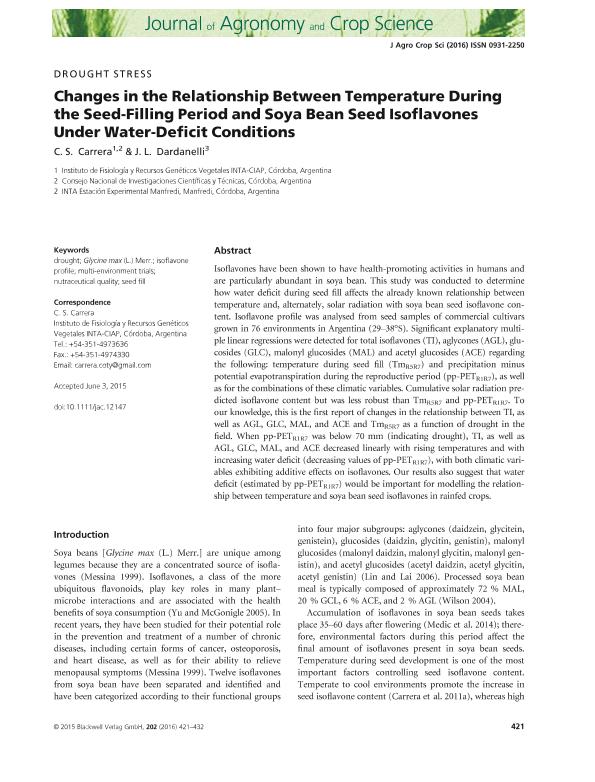Mostrar el registro sencillo del ítem
dc.contributor.author
Carrera, Constanza Soledad

dc.contributor.author
Dardanelli, Julio L.
dc.date.available
2020-06-17T10:56:56Z
dc.date.issued
2016-12
dc.identifier.citation
Carrera, Constanza Soledad; Dardanelli, Julio L.; Changes in the relationship between temperature during the seed-filling period and soya bean seed isoflavones under water-deficit conditions; Wiley Blackwell Publishing, Inc; Journal of Agronomy and Crop Science; 202; 6; 12-2016; 421-432
dc.identifier.issn
0931-2250
dc.identifier.uri
http://hdl.handle.net/11336/107537
dc.description.abstract
Isoflavones have been shown to have health-promoting activities in humans andare particularly abundant in soya bean. This study was conducted to determine how water deficit during seed fill affects the already known relationship between temperature and, alternately, solar radiation with soya bean seed isoflavone content. Isoflavone profile was analysed from seed samples of commercial cultivars grown in 76 environments in Argentina (29?38°S). Significant explanatory multiple linear regressions were detected for total isoflavones (TI), aglycones (AGL), glucosides (GLC), malonyl glucosides (MAL) and acetyl glucosides (ACE) regarding the following: temperature during seed fill (TmR5R7) and precipitation minus potential evapotranspiration during the reproductive period (pp-PETR1R7), as well as for the combinations of these climatic variables. Cumulative solar radiation predicted isoflavone content but was less robust than TmR5R7 and pp-PETR1R7. To our knowledge, this is the first report of changes in the relationship between TI, as well as AGL, GLC, MAL, and ACE and TmR5R7 as a function of drought in the field. When pp-PETR1R7 was below 70 mm (indicating drought), TI, as well as AGL, GLC, MAL, and ACE decreased linearly with rising temperatures and with increasing water deficit (decreasing values of pp-PETR1R7), with both climatic variables exhibiting additive effects on isoflavones. Our results also suggest that water deficit (estimated by pp-PETR1R7) would be important for modelling the relationship between temperature and soya bean seed isoflavones in rainfed crops.
dc.format
application/pdf
dc.language.iso
eng
dc.publisher
Wiley Blackwell Publishing, Inc

dc.rights
info:eu-repo/semantics/openAccess
dc.rights.uri
https://creativecommons.org/licenses/by-nc-sa/2.5/ar/
dc.subject
DROUGHT
dc.subject
GLYCINE MAX (L.) MERR
dc.subject
ISOFLAVONE PROFILE
dc.subject
MULTI-ENVIRONMENT TRIALS
dc.subject
NUTRACEUTICAL QUALITY
dc.subject
SEED FILL
dc.subject.classification
Otras Ciencias Agrícolas

dc.subject.classification
Otras Ciencias Agrícolas

dc.subject.classification
CIENCIAS AGRÍCOLAS

dc.title
Changes in the relationship between temperature during the seed-filling period and soya bean seed isoflavones under water-deficit conditions
dc.type
info:eu-repo/semantics/article
dc.type
info:ar-repo/semantics/artículo
dc.type
info:eu-repo/semantics/publishedVersion
dc.date.updated
2020-06-16T13:15:27Z
dc.identifier.eissn
1439-037X
dc.journal.volume
202
dc.journal.number
6
dc.journal.pagination
421-432
dc.journal.pais
Reino Unido

dc.journal.ciudad
Londres
dc.description.fil
Fil: Carrera, Constanza Soledad. Instituto Nacional de Tecnologia Agropecuaria. Centro de Investigaciones Agropecuarias. Unidad de Estudios Agropecuarios. - Consejo Nacional de Investigaciones Cientificas y Tecnicas. Centro Cientifico Tecnologico Conicet - Cordoba. Unidad de Estudios Agropecuarios.; Argentina
dc.description.fil
Fil: Dardanelli, Julio L.. Instituto Nacional de Tecnología Agropecuaria. Centro Regional Córdoba. Estación Experimental Agropecuaria Manfredi. Departamento de Producción Vegetal; Argentina
dc.journal.title
Journal of Agronomy and Crop Science

dc.relation.alternativeid
info:eu-repo/semantics/altIdentifier/doi/http://dx.doi.org/10.1111/jac.12147
dc.relation.alternativeid
info:eu-repo/semantics/altIdentifier/url/https://onlinelibrary.wiley.com/doi/abs/10.1111/jac.12147
Archivos asociados
